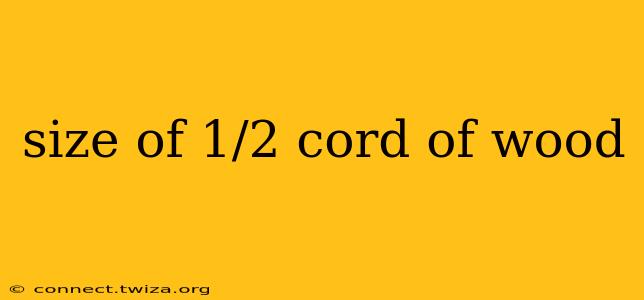Buying firewood can feel like navigating a maze of confusing measurements. One of the most common units is the cord, but what exactly does a half cord look like, and how much space will it take up? This comprehensive guide will clarify the size of a 1/2 cord of wood, helping you accurately estimate your needs and avoid any unpleasant surprises.
A standard cord of wood measures 4 feet wide x 4 feet high x 8 feet long, totaling 128 cubic feet. Therefore, a half cord is precisely half that volume: 64 cubic feet. However, the actual physical dimensions can vary depending on how the wood is stacked. Let's delve into the common scenarios.
What are the typical dimensions of a 1/2 cord of wood?
This is where things get a bit nuanced. While the volume remains constant at 64 cubic feet, the arrangement of the wood can affect the apparent size.
-
Neatly Stacked: A neatly stacked half cord might occupy a space roughly 4 feet wide x 4 feet high x 4 feet long. This represents a tightly packed arrangement, maximizing space efficiency. However, it is important to note that this idealized arrangement isn't always achievable.
-
Loosely Stacked: A loosely stacked half cord will occupy a larger volume. Air gaps between pieces of wood will increase the overall space it takes. You might find that a loosely stacked half cord takes up a larger footprint – maybe even more than 4x4x4 feet.
How much space does a 1/2 cord of wood take up?
The space a half-cord occupies depends greatly on the stacking method and the wood itself. Splitting the wood into smaller pieces allows for tighter packing and reduces the overall space required. The type of wood also matters, as irregular shapes will leave more air gaps compared to uniformly sized pieces.
It's best to think of the 64 cubic feet as a minimum volume. You should always allow for some extra space to accommodate for the less-than-perfect packing.
What is the difference between a face cord and a half cord?
This is a common source of confusion. A face cord refers to a stack of wood that is 4 feet high and 8 feet long, but the depth (or thickness) is variable. It's crucial to know the depth of your face cord before buying, as a shallow face cord might only contain a fraction of a full cord. The depth varies greatly depending on the supplier and the size of the wood pieces.
A half-cord, on the other hand, always equals 64 cubic feet (regardless of the stacking method).
How do I calculate the amount of firewood I need?
Calculating your firewood needs depends on several factors:
- The size of your space: How many square feet do you need to heat?
- The efficiency of your stove or fireplace: Different appliances have varying heating capacities.
- The type of wood: Different types of wood have different BTU ratings (British Thermal Units), impacting their heat output.
- Your climate: Colder climates naturally require more firewood.
Consulting with a local firewood supplier is highly recommended. They can provide tailored recommendations based on your specific needs and preferences.
Can I estimate the amount of wood visually?
Visual estimation can be tricky and unreliable. The varying stacking methods and the natural irregularities of wood make accurate visual assessment almost impossible. Relying solely on visual estimates can lead to significant overestimation or underestimation. It's crucial to use volume measurements as the main guide to avoid disappointment and ensure you have enough wood for the winter.
This comprehensive guide aims to provide a clear understanding of the size and volume of a half cord of firewood. Remember, while 64 cubic feet is the standard volume, the actual space occupied can vary. Precise measurement and clear communication with your supplier are key to getting the amount of firewood you need.
